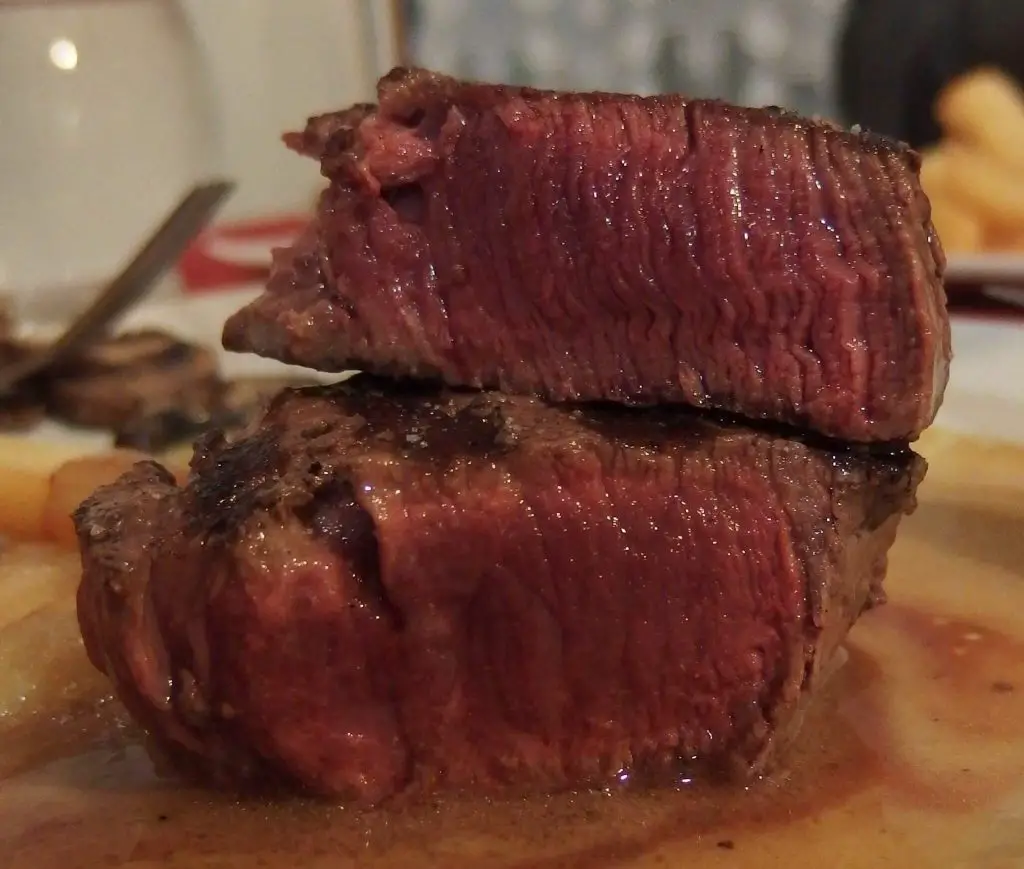If you’ve recently come across the term blue steak but are not quite sure what it means, don’t worry, you’re not alone.
So what is blue steak?
Blue steak is something that few have heard of before, so it makes sense that you would want to learn more about it.
In this article, we’ll talk about what blue steak is, why your steak has a blue tinge and whether or not it’s harmful.
Let’s get to it…
Contents
What Exactly Is Blue Steak?
Blue steak, also known as bleu is a mark of French tradition, it’s achieved by cooking cold steak at a high temperature for a short amount of time.
This sears the outside of the steak and gives it a crunchy texture that many people enjoy, whilst still having a rare steak.
Blue steak is the stage of doneness before rare, meaning it’s barely cooked before being taken off the heat and eaten.
In fact, to achieve a blue steak the meat only needs to be cooked for 1 minute on either side to reach that textured exterior.
The inside of the steak will look raw, but this is what blue steak is supposed to look like.
Blue steak is more common in the United States than it is in Europe.
It’s not for everyone as most prefer a medium-rare steak, however as mentioned it is a French tradition and is quite popular there as well as in the US.
The name blue steak is used because when the steak is cut, raw meat has a blue/purple color to it as the oxygen from the air is unable to fully penetrate it.
Once the meat is exposed to the air, the myoglobin begins to become oxygenated into the bright red color that we associate with steak.
This means unless you are actually witnessing the meat first get sliced, you’ll likely not see any blue at all.
Is Blue Steak Safe To Eat?
Is blue steak safe to eat? Absolutely. Although it may seem dangerous to eat a steak that has only been cooked for one minute on either side, it’s completely safe. As soon as the steak is dropped on your plate, the cooking process will stop.
The reason for this is the structure of beef and how it reacts to heat.
When you cook a piece of beef at high temperatures for an extended period of time, that’s when you get things like well-done steaks.
There are some risks associated with eating blue steak, for example, the bacteria in the meat may be killed by the intense heat, but not completely.
Eating undercooked meat could lead to health risks such as food poisoning.
However, this should not be a problem when eating blue steak because it’s cooked at such high temperatures for such a short amount of time.
There is one precaution you MUST ensure before deciding to cook up your own blue steak.
The whole outer surface of the steak, including the edges, must be completely charred.
If there are any gray parts left, then the meat will not be safe to eat and you should probably try again another time.
This is because E.coli will be on the outside of the raw meat that is exposed, so it’s important to ensure that the whole surface area of the steak is charred before eating blue steak.
Is Blue Steak Raw?
Blue steak and raw steak are different in the sense that blue steak is cooked and raw steak can be eaten in its uncooked state.
Many assume that blue steak is actually not cooked at all and this has led to the myth that blue steak contains raw beef.
Although blue steak isn’t rare, this level of doneness is the lowest.
Meaning that it wouldn’t be safe to eat steak if it was any less cooked than blue.
This is because as mentioned above, bacteria are present on the outside of the steak which needs to be seared off before human consumption.
If this isn’t done, then you’re putting yourself at risk of food poisoning and becoming very ill.
What Is The Difference Between Blue And Rare Steak?
There is a difference between a blue and rare steak that it’s important to be aware of if you’re considering ordering blue.
Blue steak is a level of doneness that comes BEFORE rare and is just shy of being named raw steak.
This is because it is seared for such a short amount of time simply to give it that textured exterior and make it safe for consumption.
Without eating raw steak, you couldn’t get any less done. Whereas rare steak is more cooked and will have around 75% red in the middle.
Blue steak will be 100% red throughout as it is only seared on the outside for a very short amount of time and is barely cooked.
The temperature of a blue steak when being “cooked” if you can call it that does not exceed 115°F.
If you’re not too sure about giving blue steak a try, then I recommend opting for a rare steak instead.
If you find that rare steak isn’t to your taste and you would prefer it a little less done, then blue steak may be the right choice for you.
How Long Is Blue Steak Cooked For?
Blue steak is cooked for very little time and is generally served quite rare.
The cooking time of blue steak depends on the thickness. Generally speaking, if the steaks are around 2cm thick then they will only need to be seared for 30 seconds – 1 minute per side (both sides).
This is to ensure that any bacteria or pathogens are killed off while also giving the steak a little color.
Cooking blue steak is a fine balance between not killing too much of the bacteria but also cooking it enough that it is safe for a human to eat.
Other Considerations
It’s worth keeping in mind that blue steak is a type of beef steak that is being eaten raw or undercooked.
This requires consideration for safety reasons, cooking the steak to a well-done style will not produce blue steak!
Blue steak should be served by itself and ideally on a medium to hot plate (not too cool).
This will ensure that the plate heats the steak up enough to make it blue instead of keeping it at room temperature.
Blue steak is typically served with a side of fat. This will help the consumer when trying to cook the meat by adding some oil into the mix and making sure that each part of the meat has a bit of oil on it so that it does not dry out.
Another consideration is how the steak is cut. Strips of meat are more likely to turn out blue than chunks, due to having a flat surface which allows it to come in contact with more of the hot oil or pan that will be used for cooking it.
A potential side dish that can be served with blue steak is fries, potatoes, and grilled vegetables.
Remember to be incredibly careful when eating blue steak as it is riskier than eating a medium-rare or medium-well steak.
If you’re someone that does enjoy blue steak, then it’s worth checking out some of the recipes that can be found online.
Conclusion
So, what is blue steak? It is a level of doneness for steak that comes before a rare steak.
This is often achieved by cooking the steak at a heat that will turn it blue, but not cook much of the meat.
The result of this cooking process is a steak that has almost no red or pink juices in it and remains very much raw.
Although there are risks associated with consuming such a meal, some people still do so and swear by eating their steak blue.
Thanks for taking the time to read this post and I hope you have learned a thing or two about blue steak.

